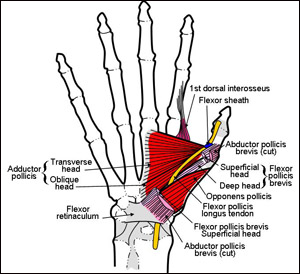 A new “diagnosis,” the pain caused by specific repetitive stress to the arm and hand muscles that bend the thumb is of increasing importance due to our hand-held texting devices like the Blackberry.
A new “diagnosis,” the pain caused by specific repetitive stress to the arm and hand muscles that bend the thumb is of increasing importance due to our hand-held texting devices like the Blackberry.
 To press the keys with the device in the palm of the hand requires flexing the tip of the thumb inward and downward. That first action of the thumb tip uses the long flexor (flexor pollicis longus). The part of that muscle located in the thumb is only it’s tendon, attaching to the bone of the last joint of the thumb (distal phalanx). The other end of the muscle and the muscle belly are both located in the forearm, up as far as the elbow!
To press the keys with the device in the palm of the hand requires flexing the tip of the thumb inward and downward. That first action of the thumb tip uses the long flexor (flexor pollicis longus). The part of that muscle located in the thumb is only it’s tendon, attaching to the bone of the last joint of the thumb (distal phalanx). The other end of the muscle and the muscle belly are both located in the forearm, up as far as the elbow!
So to bend the thumb, the long flexor in your forearm contracts and pulls on the tip of the thumb. First, it bends the distal phalanx, then the middle phalanx, then it folds the thumb inward toward the wrist and finally bends the wrist itself.

This long flexor is assisted intrinsically (within the thumb) by two “heads” of the short flexor, superficial and deep (flexor pollicis brevis). They both attach to the middle phalanx stacked on top of one another pulling on that bone from their attachments to the connective tissue and ligament at the wrist.
If your hand position is cupped at the palm, you are also using two other short intrinsic muscles that bring the long bone (metacarpal) of the thumb toward the index finger (adductor pollicis) and toward the pad of the pinkie (opponens pollicis).
All of these muscles work closely together to accomplish the complicated movements of the thumb during texting activity.
The pain in the thumb comes from four basic sources:
1) Overuse of these muscles, contracting for sometimes hours a day. The work required to flex the thumbs for prolonged periods of time uses up the fuels the muscles need to work and tenses them, causing pain.
2) Another source of pain comes from the waste products generated by the burning of these metabolic fuels. Wastes are deposited in the fluids around and within the muscle which build up when the fluids don’t flow efficiently to remove them. When muscles are tight, the blood flow is reduced by 20%. Eventually that causes a buildup of these acidic and pain-causing waste products.
3) Trigger Points in all of these muscles can refer pain into the thumb. The hyperactivity and hypersensitivity of a Trigger Point shoots or “spreads” pain out from it’s location.
4) Joint pain can result from tension or friction within a joint causing the nerves to become irritated and the joint inflamed.
To reduce or eliminate pain, the muscles that are abused need effective stretching, regular breaks, Neuromuscular Therapy treatment and self-applied manual therapy to keep them healthy. Blackberry thumb is treated in my pain treatment center near Boston.
This is a series on arm and hand pain. If you missed the beginning, go back to the “Checklist of Causes.”
Found this information very useful. I am suffering from blackberry thumb and have pain that extends to the upper arm.